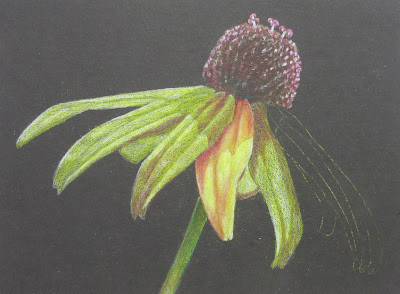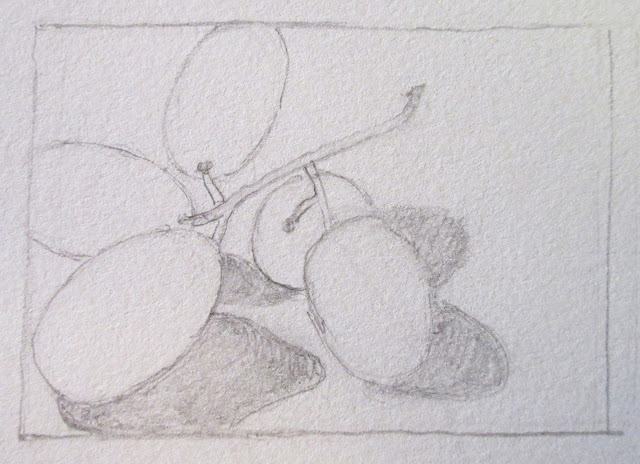 |
| I glazed the bottom left grape with a yellow glaze and scrubbed a highlight on the top left of that grape. |
 |
| I glazed the background with a red glaze. |
 |
| I glazed the bottom left grape with a yellow glaze and scrubbed a highlight on the top left of that grape. |
 |
| I glazed the background with a red glaze. |
 |
| Blind contour, hand |
 |
| Drawing marks (hatching, cross hatching (with my messy cross hatching/scumbling mix next to it), contour hatching, scumbling, stippling, using words to shade. |
 |
| The start of a contour hand using a grid matching the plexi viewfinder grid. Your homework - practice, practice, practice! |
 |
| Blind contour |
 |
| Thumbnails |
 |
| Drawing |
 |
| Warm/cool color wheel. |
 |
| Worked more on the bottom 2 grapes as well as the stem. |
 |
| Flat wash and graded wash. |
 |
| I worked on a petal at home, blending and refining. |
 |
| I demonstrated a petal in class, blending and refining. I used white, canary yellow, cad orange, and pomegranate working in layers switching between pencils as I adjusted the values and colors. |
 |
| I used true blue and did a light value study (started it at home). Remember to use the pencil AND the poster putty to lift as needed. |
 |
| Worked on the body with true blue, indigo blue, black grape, white, pomegranate, and a little yellow (on the chest). It needs a little more dark and feather textures. |
 |
| Worked on the clothes and some background and some more leaves. Still needs quite a bit of work. When I work on this I will plan to post photos and email the class. |
 |
| Worked on the background and leaves. Everything needs another few passes. |
 |
| A tree started with the leaf clumps, added trunk and branches while it was wet. |
 |
| First pass was wet on wet. The second pass was wet on dry (did not finish, would add another small tree on the right. Would most likely do more passes adding small details, darks, and textures. |
 |
| One of the blind contours. The purpose of a blind contour is as a warm up and to focus the artist, to get them to really look at and SEE the subject they are drawing. |
 |
| Thumbnail sketches. These are used to try various compositions, shapes, values, etc. before doing the final drawing. |
 |
| This is a sketch, a slightly more finished sketch than a thumbnail. I did this sketch so that I could see the positive and negative shapes and the composition I had chosen a little better. |
 |
| Colored reference photo of my fruit still life. |
 |
| Finished drawing transferred to watercolor paper (my original drawings are most often done on tracing paper and transferred). |
 |
| Flat wash on the left graded wash on the right. I worked wet on dry. |
 |
| Flat wash on the left graded wash on the right. I worked wet on dry. |
 |
| Step one of the dark on light. Used pomegranate to do a value study. I left a few petals unfinished in case they are needed for demonstration purposes. |
 |
| The second step was to add yellow to the entire flower. This reduces the value contrast which we will re-establish in later steps. |
 |
| First step of light on dark is to do a value study in white. I left a few petals unfinished in case they are needed for demonstration purposes. |